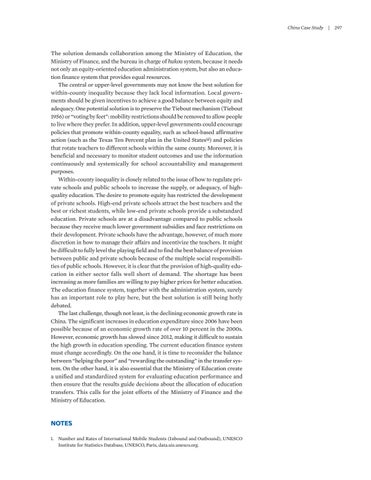China Case Study | 297
The solution demands collaboration among the Ministry of Education, the Ministry of Finance, and the bureau in charge of hukou system, because it needs not only an equity-oriented education administration system, but also an education finance system that provides equal resources. The central or upper-level governments may not know the best solution for within-county inequality because they lack local information. Local governments should be given incentives to achieve a good balance between equity and adequacy. One potential solution is to preserve the Tiebout mechanism (Tiebout 1956) or “voting by feet”: mobility restrictions should be removed to allow people to live where they prefer. In addition, upper-level governments could encourage policies that promote within-county equality, such as school-based affirmative action (such as the Texas Ten Percent plan in the United States12) and policies that rotate teachers to different schools within the same county. Moreover, it is beneficial and necessary to monitor student outcomes and use the information continuously and systemically for school accountability and management purposes. Within-county inequality is closely related to the issue of how to regulate private schools and public schools to increase the supply, or adequacy, of high- quality education. The desire to promote equity has restricted the development of private schools. High-end private schools attract the best teachers and the best or richest students, while low-end private schools provide a substandard education. Private schools are at a disadvantage compared to public schools because they receive much lower government subsidies and face restrictions on their development. Private schools have the advantage, however, of much more discretion in how to manage their affairs and incentivize the teachers. It might be difficult to fully level the playing field and to find the best balance of provision between public and private schools because of the multiple social responsibilities of public schools. However, it is clear that the provision of high-quality education in either sector falls well short of demand. The shortage has been increasing as more families are willing to pay higher prices for better education. The education finance system, together with the administration system, surely has an important role to play here, but the best solution is still being hotly debated. The last challenge, though not least, is the declining economic growth rate in China. The significant increases in education expenditure since 2006 have been possible because of an economic growth rate of over 10 percent in the 2000s. However, economic growth has slowed since 2012, making it difficult to sustain the high growth in education spending. The current education finance system must change accordingly. On the one hand, it is time to reconsider the balance between “helping the poor” and “rewarding the outstanding” in the transfer system. On the other hand, it is also essential that the Ministry of Education create a unified and standardized system for evaluating education performance and then ensure that the results guide decisions about the allocation of education transfers. This calls for the joint efforts of the Ministry of Finance and the Ministry of Education.
NOTES 1. Number and Rates of International Mobile Students (Inbound and Outbound), UNESCO Institute for Statistics Database, UNESCO, Paris, data.uis.unesco.org.






